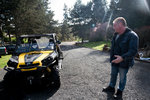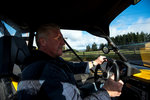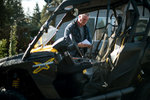


Jon Swegle doesn’t want to race his deluxe ATV all over Lewis County like some contemporary rendition of “Mad Max.”
He just wants to ride it over to his friend’s house on the Newaukum River to go fishing for steelhead.
Despite his modest desire, Swegle has been restrained by regulations and red tape, and now his side-by-side utility terrain vehicle just sits idle in the garage.
Swegle, 50, of Chehalis, purchased his Rotax 1000 model UTV last June. He then found out that it’s possible to make the recreation vehicles street legal in Washington with just a few upgrades. In November, Swegle took his rig to Dave McCaslin at Powersports Unleashed for the required makeover. State law requires blinkers, a horn and an inside rearview mirror on road-legal vehicles. Swegle went all-in though, and his impressive ride is outfitted with a dump trailer, high beams, a license plate light, brake lights, side mirrors, a windshield, roll cage and insurance.
All told, he put $850 into the modifications that were intended to give him access to the streets of Washington.
Things have been a little tricky since that trip to the shop, though.
Washington State law allows licensed ATVs on public roads with speed limits of 35 miles per hour or less, but it also leaves the adoption of that law up to individual counties. Some counties, such as Wahkiakum and Skamania, automatically adopted the law due to their low population densities, but the decision was left up to counties with larger populations.
In Western Washington, so far only Grays Harbor, Clallam and Pacific counties have acted to adopt the road usage law.
Misinformation abounds, though, and some folks are certain that with the required modifications they can drive the recreation vehicles all over. Swegle was one of those riders, and he has been pulled over twice so far for driving his decked-out rig on public roads.
“They haven’t given me a ticket yet, they just told me not to drive it anymore,” said Swegle, who noted the Washington State Patrol threatened to impound his vehicle.
For his part, Swegle doesn’t understand what all the fuss is about.
“It’s fun. This thing will do 80 miles per hour,” said Swegle. “And they’re safe. It’s got a seat belt and a roll cage. This isn’t like a three-wheeler in the ‘70s. I mean, they’re safe.”
The four-wheeled rigs are also good on gas. Swegle doesn’t understand what he considers to be reactionary, overblown safety concerns. Swegle owns an impressive menagerie of driveable toys including a Camaro, a Mustang, a Corvette, a Porsche and a hot-rod. All of them are street legal, but Swegle said, “I’d probably feel better in this,” in the event of a wreck on the road.
“If you get hit in this,” said Swegle, pointing at his canary colored hot-rod, “I mean, you’re done. You might as well be riding a pogo stick.”
Dave McCaslin, at Powersports Unleashed, said, “Any road in Washington state that is posted 35 miles per hour or slower is legal to ride on as long as the conversions are made.”
According to lobbyists, county commissioners and law enforcement, however, that is simply not the case in Lewis County or most Western Washington counties for that matter.
In Grays Harbor County, folks are free to ride their licensed and equipped ATVs right through town. It would appear that the wheels of change roll slower in Lewis County.
“He was pulled over,” admitted McCaslin of his customer, Swegle. “There’s a certain Washington State Patrol officer who has given a number of my customers tickets and he pulled him over and told him that if he saw him with it out again he’d impound it because it’s not legal.”
McCaslin added, “A lot of people are just sticking to the back roads and taking their chances with it. Jon was pretty blatant about it. He took it to Walmart.”
McCaslin says he has converted about nine ATVs to quasi-road legal status recently, with another two or three in the works. In his opinion, the vehicles are as safe as can be.
“I mean, how many cars do you see on the road with roll cages?” asked McCaslin.
Swegle and McCaslin are not alone in their desire to see ATVs given the green light to go ahead on public roads, and the Cowlitz Basin ORV Club is one local organization working hard to make that a reality.
On Monday, the offroad vehicle club made a proposal to the county commissioners that would open up all public roads east of Lake Mayfield, with speed limits of 35 miles per hour or less, to modified ATV traffic.
Steve Pendleton, president of the Cowlitz Basin ORV club, said they chose the area east of Lake Mayfield because “that area is least resistant,” to the idea. He is hopeful that the proposal will be put into action within the next four months.
“It’s just like anything, there’s pros and cons to it,” said Pendleton.
The club president considers ATVs to be safer than motorcycles at the very least.
“You’ve got four wheels and you’re only going 35,” he said.
Pendleton confirmed the road-wary status of ATVs in Lewis County, too, noting that there are currently no public roads on which it is legal to ride. He added that off-road driving is also limited to Department of Natural Resources land, with no access to vast tracts of private timber company land.
Ted Jackson is a lobbyist who came to Chehalis on Monday to speak on behalf of the Cowlitz Basin ORV Club and its proposal to open some Lewis County roads to ATV travel.
“The goal here is to provide local residents with alternative forms of transportation,” said Jackson, who envisions a network of off-road trail hubs connected by public roads where ATVs are allowed. He says such systems draw in tourists and noted that 13 states and one Canadian province with similar systems generated $11.9 billion in tourism dollars in 2012 alone.
“ATVs are nothing but motorcycles with four wheels, and we’ve got motorcycles on the streets all the time,” said Jackson.
Lewis County Commissioner, Gary Stamper, considers himself an ally to the ATV crew, and he has been working with the ORV club as well as Sheriff Rob Snaza on the issue for the last three months.
“I think it’s a positive thing,” said Stamper. “I’ve been educated.”
Although Stamper is a little more reserved in his time frame estimate for action on the ORV club’s proposal (6-8 months), he is optimistic that progress will be made for ATV riders.
“It’s always going to come down to safety,” said Stamper. “There’s always going to be people who are uniformed with it but that’s what public dialogue is for.”
Swegle, the side-by-side UTV owner with a hankering to hit the road, agreed with Stamper’s assessment of unjustified public fears. “People say you’re going to have people doing wheelies on the road, and you know what, the cops will write them tickets,” Swegle said. “But I’m a law-abiding citizen.”